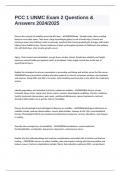PCC 1 UNMC Exam 2 Questions &
Answers 2024/2025
Discuss the concept of mobility across the life span. - ANSWERSInfants - Straight spine, them crawling
tends to curve their spine. They have a large head keepin gthem at risk of head injury. Muscle and
training is used. Any child born with an anomaly, overtime their bones gradually get stronger and harder.
Infancy have flexible bones. Muscle continues to beef up throughout growth of childhood. One puberty
hits with both boys, their muscle growth occurs.
Aging - Does impact musculoskeletal, you get dryer, weaker, slower. People lose elasticity and height
becomes reduced leading to kyphosis which is humpback. More fragile vessels due to the lack of
superficial fat layers.
Explain the strategies for primary prevention in promoting well-being and activity across the life course. -
ANSWERSPrimary prevention includes education patients on how to eat proper portions, stay hydrated,
and exercise. Doing ROM and ADL's can assist, even breathing exercises play a role within the respiratory
system.
Identify population and individual risk factors related to mobility. - ANSWERSRisk factors include
tramautic injury: brain, spinal cord, bones, joints, muscles. Neurological conditions. Chronic conditions
(and/or treatment interventions, pain meds, nutritional deficiencies, cancer treatments, corticoid
steroids.) Older adults are at greater risk for immobility.
Discuss the physiological and patholigical influences on mobility. - ANSWERSPathological influences on
mobility include, postural abnormalities, muscle abnormalities, damage to the CNS, musculoskeletal
trauma. Physiological effects are emotional and behavioral responses, sensory alterations, and changes
in coping.
Describe the consequences of immobility. - ANSWERSSkin breakdown, muscle weakness,
thombophlebitis, constipation, pneumonia, depression, and pressure ulcers.
Explain why the pathophysiology and common complications associated with a fracture and fracture
healing. - ANSWERSFractures can affect mobility; pain pain impairs it along with the prescriptive and
balance issues. Fracture complications include: Shock, fast embolism syndrome (FES), compartment
,syndrome, venous thrombosis embolism. With fracture healing, you want to control the pain, wiggle
fingers and toes, elevate, ice, antibiotics may be indicated if the bone beccomes infected. Make sure that
you are careful with cast placement or else you cause a pressure within it.
Apply the nursing process to patients with immobility, and fractures. - ANSWERSPatient's with pre-
existing mobility impairments and those who are at risk for immobility will greatly benefit from a care
plan that improves the patient's functional status, promotes self-care, maintains psychological well-
being, and reduces the hazards of immobility.
Describe the etiology, pathophysiology, clinical manifestations and nursing care of the patient with
osteoporosis. - ANSWERSEtilogy: Osteoporosis occurs when there is an imbalance between new bone
formation and old bone resportion. The body may fail to form enough new bone, or too much old bone
may be reabsorbed, or both.
Pathophysiology: Risk factors, postmenopausal, family history, diet low in calcium, excessive use of
alcohol, certain drugs, diabetes.
Clinical manifestations: Back pain, caused by a fractured or collapsed vertebra, loss of height overtime, a
stooped posutre, a bone that breaks much more easily than expected.
Nursing care: Get the proper amount of calcium and Vitamin D. Calcium intake is essential to prevent
bone loss and important. Prevent falls by providing a safe environment. Medications to avoid more bone
loss, limit salt, caffeine, soda, alcohol.
Describe critical thinking. - ANSWERSThe ability to think in a systematic an logical manner with openness
to question and reflect on the reasoning process.
Describe clinical judgement. - ANSWERSDecisions about the patient and their families in your care.
Evaluate the understanding of critical thinking. - ANSWERS- It involves open-mindedness, continual
inquiry, and perseverance, combined with a willingness to look at each unique patient situation and
determine which identified assumptions are true and relevant.
, - It's not a simple step-by-step process. It is gained through experience, commitment, and an active
curiosity toward learning.
Apply clinical judgment to the care of a hospitalized patient. - ANSWERSAn RN observes for changes in
patients, recognizes potential problems, identifies new problems are they arise, and takes action when a
patient's clinical condition worsens.
Apply critical thinking to the care of a hospitalized patient. - ANSWERSWhen a patient develops new set
of symptoms, asks you to offer comfort, or requires a procedure, it is important to think critically and
make sensible judgements so that the patient receives the best nursing care possible.
Review therapeutic communication in nursing. - ANSWERS- Therapeutic relationships are patient
focused, it exists for the needs and goals of the patient.
What is a therapeutic nurse-patient relationship? - ANSWERSCentral to the implementation phase.
Collaboratively you develop the goals and outcome criteria and then consider nursing interventions for
promoting a healthy self-concept and helping a patient move toward his or her goal. As the nurse-
patient relationship develops, the nurse and patient mutually define the problems and potential
solutions. When the patient's original needs are resolved, new needs sometimes emerge. This middle-
range theory is useful in establishing effective nurse-patient communication when obtaining a nursing
history providing patient education, or counseling patients and their families.
Identify elements of effective communication. - ANSWERS- Caring for others
- Being genuine
- Listening to the patient/other nurses/doctors
- Establishing guidelines
- Focusing at all times
- Giving respect
- Accepting all types of people
- Trust
- Showing empathy
- Using open ended questions with patients
- Reflecting on your decisions and time spent throughout the day




